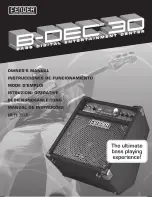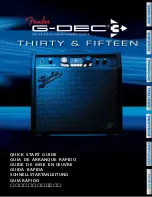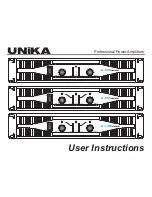
CONTROLS AND CONNECTIONS
43
|
PreSonus 2008
3.6 BACK PANEL LAYOUT
Power Adaptor Input.
This is where you plug in the proprietary power supply. The FireStudio features
a locking connector to ensure solid power connectivity.
FireWire Ports.
There are two standard 6-pin FireWire ports on the back of the FireStudio. Either
(and only one) should be used to connect your FireStudio to a vacant FireWire port on your computer.
If your computer has a 4-pin connector (commonly found on laptops), you will need a 4 to 6-pin
connector to connect your FireStudio to your computer.
Use the ‘extra’ FireWire port to connect additional FireWire devices to you computer (such as external
Hard Drives, etc).
MIDI In and Out Ports.
MIDI stands for “Musical Instrument Digital Interface”. However, the MIDI
standard goes well beyond just instrumentation and sequencing. The MIDI inputs and outputs allow
connection and/or communication with external MIDI equipment. One function of this port is MIDI
programming. These can also be used for MMC (MIDI Machine Control) and MTC (MIDI Time Code).
NOTE:
MIDI is not audio
but is frequently used to trigger or control an audio source (such as a VST
plugin or synthesizer). When using MIDI, ensure your MIDI data is correctly sent and received
by the appropriate hardware or software instruments. If you are using an external MIDI
devices like a synthesizer or a sampler, you will need to connect the audio output of the device
to an analog or digital input on the FireStudio in order to record it as audio. Please consult
the User’s Manual of your MIDI devices for help with MIDI setup and usage.
BNC Input and Output.
These allow the FireStudio to receive and transmit word clock to and from
other digital audio devices.
You will need to select “wordclock” as the Clock Source in the FireStudio Control Console when using
the BNC input. A 75ohm BNC word clock cable is required to achieve proper sync.
Summary of Contents for FIRESTUDIO MOBILE - SCHEMA
Page 4: ......







































